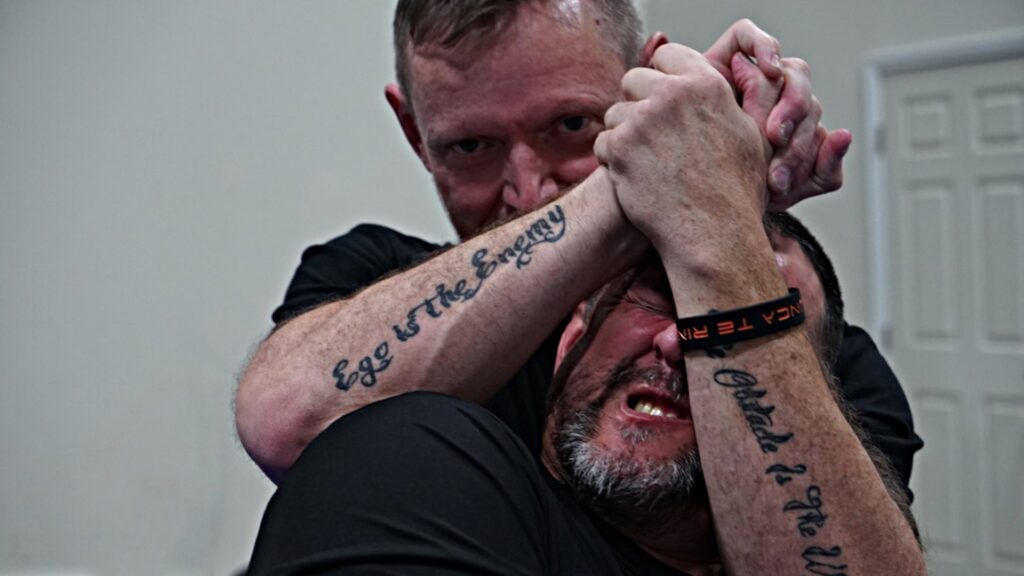
Don’t let your martial arts training confine your potential. In previous discussions, I’ve emphasized the importance of avoiding becoming too systemized in your approach to learning martial arts. By this, I mean that it’s crucial not to let the beliefs and doctrines of any single martial arts system wholly shape your perspectives.
Take, for instance, the common saying in some circles that “all fights go to the ground.” While this statement may hold some truth in specific contexts, such as in certain types of grappling or mixed martial arts competitions, it is by no means a universal truth. Anyone with practical sense can see that fights can be highly variable and unpredictable, and insisting otherwise can limit a martial artist’s preparedness and adaptability.
However, some practitioners become so deeply embedded in their martial arts community’s culture that they begin to accept such statements as fact, without any personal evidence or broader experience to support them. This can be detrimental, as it narrows their understanding and can potentially hinder their ability to handle diverse combat situations effectively.
Combat artists must maintain a critical mindset and question the doctrines presented to them, no matter how deeply ingrained these may be within their chosen style. Expanding your knowledge across different styles and theories and integrating diverse techniques and strategies can significantly enhance your versatility and effectiveness as a martial artist.
By keeping an open mind and continuously seeking varied experiences and viewpoints, you can avoid the pitfalls of becoming too rigidly attached to any one system’s ideology. This approach not only broadens your technical repertoire but also deepens your overall understanding of martial arts as a multifaceted discipline.
Delving further into this topic, adhering strictly to a specific system can restrict your grasp of the entire range of violence due to the ingrained beliefs of the system. I will explore this concept more thoroughly shortly, but first, it’s important to define what I mean by the “Full Spectrum of Violence.“
Full Spectrum Of Violence
Picture a scale from 1 to 10, where 1 represents low-level control techniques or mild responses to aggression from a potential threat, and 10 signifies the most intense, violent, and aggressive methods to conclude an encounter with a possible danger.
It’s crucial to be versatile and capable of responding appropriately anywhere along this scale. However, due to ingrained beliefs and teachings, some martial arts systems might limit training to operate only within a certain range of this spectrum, perhaps only up to a level 5 or 6. For example, consider learning a joint lock or a choke within a grappling system; these techniques can be highly effective within certain contexts.
However, if multiple attackers confront you in a threatening situation, such as being cornered in an alley while defending your family, relying solely on a choke or armbar might not meet the level of force or level of violence needed. In such scenarios, the limitations of training only to a mid-level of violence become apparent. Suppose your preparation doesn’t include the ability to escalate to more decisive and powerful defensive actions when necessary. In that case, you might find yourself inadequately prepared to handle such high-stakes situations effectively. This illustrates the importance of a comprehensive approach encompassing the full spectrum of violence.
Exploring the higher levels of violence within martial arts training can be uncomfortable and even disturbing. Learning about and practicing techniques that involve significant force or the potential to cause serious harm is not a pleasant endeavor. However, the reality is that these skills are crucial in situations where lesser measures are insufficient for your safety or the safety of others. Ultimately, the goal of learning these intense and less pleasant aspects of self-defense is not to foster aggression but to equip individuals with the necessary tools to protect themselves and others effectively under extreme circumstances. It is about making informed, responsible choices and having the skills to back them up when all other options have failed.
The principle of “better to know them and not need them, than to need them and not know them” is particularly relevant in this context. The idea is to be prepared for the worst while hoping for the best. In practical terms, this means having the capability to escalate your response appropriately when confronted with severe threats. The knowledge of more aggressive and decisive techniques provides a strategic advantage, ensuring that you are prepared for a dire situation.
This makes me think of the saying by Miyamoto Musashi — “It is better to be a warrior in a garden than a gardener in a war.”
“It is better to be a warrior in a garden, than a gardener in a war.” ~ Miyamoto Musashi
With this perspective, it’s vital to critically evaluate the martial arts system or method you’re practicing. Consider whether the system imposes its beliefs on you, shaping your perspective and actions without room for personal judgment. When you step back and look broadly at your training, ask yourself: Are you being indoctrinated or molded to adhere strictly to someone else’s belief systems?
It’s not uncommon to witness individuals deeply ingrained with the ideologies of their training environment or cultural background to the point where they adhere to these beliefs unquestioningly. This phenomenon often results from the comfort and security that familiarity brings. Embracing established norms and practices without scrutiny may seem safer and easier, especially when alternative paths demand rigorous effort and critical questioning.
Humans have a natural tendency to opt for the path of least resistance. Choosing familiar, well-trodden paths can seem less daunting than venturing into the unknown, which often involves challenges and the discomfort of questioning deeply held beliefs. However, while easier paths might offer short-term comfort, they can limit personal growth and the development of a truly comprehensive understanding of martial arts and self-defense.
Therefore, it is essential to foster a mindset that values critical thinking and continuous learning. By doing so, you encourage not only skill development but also intellectual and ethical growth. This approach ensures that you are not merely absorbing knowledge uncritically but actively engaging with your training to understand its deeper implications and applications.
The Predatorial Mind Is Not Limited By The Same Beliefs
When considering self-defense and martial arts, it’s essential to recognize that the predatory mind operates fundamentally differently from those who abide by societal norms and moral codes. Predators, those who willingly engage in criminal behavior, are not constrained by the same ethical considerations that guide the average person. This distinction is crucial for understanding and preparing for the realities of violent encounters.
The predatory mind does not value human life in the same way that others might. This lack of regard can lead to a readiness to employ extreme levels of violence without hesitation or remorse. Unlike a typical individual, who might grapple with moral dilemmas even in situations requiring self-defense, a predator sees violence as a tool to be wielded to achieve their ends, whatever they may be.
This means that predators often think and act outside the expected behavioral norms, and they can exploit the hesitation caused by their victims’ moral and ethical constraints. They are more likely to escalate a situation to levels of violence that a morally guided individual might not be prepared to handle, often catching their opponents off guard with their ruthlessness.
Understanding this can have profound implications for martial arts and self-defense training. Training that does not take into account the potential for extreme violence may leave individuals inadequately prepared for the worst-case scenarios. Therefore, a comprehensive approach to self-defense should include strategies for dealing with high levels of threat and aggression, recognizing that the goal is not just to match but to overcome the intensity and brutality of any assailant.
This knowledge should not inspire fear but rather a more profound commitment to preparedness. By training to meet and exceed the potential levels of violence, one might face, and by developing the mental resilience to confront such challenges without ethical hesitancy, individuals can better secure their safety and the safety of others in truly perilous situations.
A Warrior Chooses To Step Into The Unknown.
In martial arts, as in life, opting for the challenging route of diligent study and open-minded exploration can lead to a deeper mastery and a richer, more detailed understanding of the intricacies of violence and defense. Although this path is undoubtedly more demanding, it significantly enhances your practice and develops a flexible, adaptable skill set equipped to handle a wide array of situations effectively. However, this is precisely the path that a true warrior elects to follow. Despite recognizing its difficulties, warriors willingly choose it, and that choice is what defines them. This decision often leads to the humbling realization that there is always more to learn, and one never truly “arrives” at complete knowledge. Yet, despite this, a warrior continues to step forward into the unknown, continually pushing onward. This relentless pursuit of growth in the face of all challenges epitomizes the warrior spirit.
Therefore, critically evaluating what you’re genuinely training for is crucial. Although it’s unfortunate, much of what is marketed as “self-defense” may not genuinely prepare you for real-life defensive situations. Always thoroughly research, ask questions, and employ common sense! It’s essential to ensure that the training you receive is practical and applicable to the scenarios you might realistically face. My goal is to accelerate the development of the warrior’s mindset and foster a greater prevalence of the fighter’s mindset globally. I aim to create and provide cutting-edge training and knowledge, equipping individuals to be better prepared for life’s challenges and the possibility of violence. Additionally, I want to teach people to take responsibility for all aspects of their lives, strive to rise to a higher level, and not have to rely on or depend on others.
Shift Your Perspective, Take the Action, Transform Your World.
~ Sifu Alan
Join Our Email List HERE
Join our Video Training Academies

Alan Baker is renowned for his dual expertise in crafting tailored Defensive Tactics Programs and high-performance coaching. Catering specifically to law enforcement agencies, military organizations, and security firms, Alan designs training regimens that emphasize practical techniques, real-world adaptability, and scenario-based training. His approach enhances the capabilities and readiness of personnel in intense situations. Explore Alan’s tailored programs here.
Beyond mere tactics, Alan stands out as the paramount “mindset” coach, adept at unlocking the vast potential within individuals. With a deep passion for mentoring professionals, entrepreneurs, and those on personal growth odysseys, he focuses on nurturing a mindset of excellence. Alan’s coaching hinges on practical strategies that bolster mental resilience, focus, and drive. Teaming up with Alan means embarking on a transformative path where mental barriers are dismantled, inherent strengths come to the fore, and your goals become within clear sight. His profound insights enhance performance and sculpt a mindset tailored for triumphant success.
To delve deeper into Alan’s mindset philosophy, peruse his enlightening collection of books And if you’re ready to amplify your journey under Alan’s tutelage, connect through his official website.

